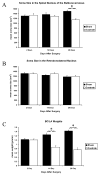Time course of adult castration-induced changes in soma size of motoneurons in the rat spinal nucleus of the bulbocavernosus
- PMID: 19429073
- PMCID: PMC2688770
- DOI: 10.1016/j.neulet.2009.02.059
Time course of adult castration-induced changes in soma size of motoneurons in the rat spinal nucleus of the bulbocavernosus
Abstract
The spinal nucleus of the bulbocavernosus (SNB) innervates striated muscles, the bulbocavernosus and levator ani (BC/LA), which control penile reflexes. Castration results in shrinkage in the size of SNB somata and dendrites, as well as BC/LA muscle mass. However, there is no information about how quickly these regressive changes occur compared to the rapid effects of castration upon penile reflexes, which are greatly diminished a few days after surgery. Therefore we examined the time course of change in the size of SNB somata after castration of adult male rats. Males were sacrificed 2, 14, or 28 days after either castration or sham surgery and somata were measured in the SNB and in a control population of motoneurons, the retrodorsolateral nucleus (RDLN). BC/LA weight was reduced in castrates compared to intact males 14 and 28 days post surgery, but SNB somata were significantly smaller in castrates only at 28 days after surgery. As has been previously observed, castration did not affect soma size in the RDLN. These data indicate that SNB somata respond more slowly after castration than BC/LA mass or penile reflexes, suggesting that the size of SNB somata cannot account for the loss of penile reflexes. Androgenic effects on SNB somata may contribute to aspects of reproductive behavior that are not apparent in penile reflexes tested ex copula.
Figures

Similar articles
-
Evidence that androgen acts through NMDA receptors to affect motoneurons in the rat spinal nucleus of the bulbocavernosus.J Neurosci. 2002 Nov 1;22(21):9567-72. doi: 10.1523/JNEUROSCI.22-21-09567.2002. J Neurosci. 2002. PMID: 12417681 Free PMC article.
-
Androgen-sensitivity of somata and dendrites of spinal nucleus of the bulbocavernosus (SNB) motoneurons in male C57BL6J mice.Horm Behav. 2007 Feb;51(2):207-12. doi: 10.1016/j.yhbeh.2006.10.003. Epub 2006 Nov 28. Horm Behav. 2007. PMID: 17126837 Free PMC article.
-
Castration reduces motoneuron soma size but not dendritic length in the spinal nucleus of the bulbocavernosus of wild-type and BCL-2 overexpressing mice.J Neurobiol. 2002 Nov 15;53(3):403-12. doi: 10.1002/neu.10103. J Neurobiol. 2002. PMID: 12382267
-
The spinal nucleus of the bulbocavernosus: firsts in androgen-dependent neural sex differences.Horm Behav. 2008 May;53(5):596-612. doi: 10.1016/j.yhbeh.2007.11.008. Epub 2007 Nov 28. Horm Behav. 2008. PMID: 18191128 Free PMC article. Review.
-
Androgen regulates gene expression of cytoskeletal proteins in adult rat motoneurons.Horm Behav. 1994 Dec;28(4):357-66. doi: 10.1006/hbeh.1994.1032. Horm Behav. 1994. PMID: 7729804 Review.
Cited by
-
Neonatal androgen-dependent sex differences in lumbar spinal cord dopamine concentrations and the number of A11 diencephalospinal dopamine neurons.J Comp Neurol. 2010 Jul 1;518(13):2423-36. doi: 10.1002/cne.22340. J Comp Neurol. 2010. PMID: 20503420 Free PMC article.
References
-
- Breedlove SM, Arnold AP. Hormone accumulation in a sexually dimorphic motor nucleus of the rat spinal cord. Science. 1980;210:564–566. - PubMed
-
- Breedlove SM, Arnold AP. Sexually dimorphic motor nucleus in the rat lumbar spinal cord: response to adult hormone manipulation, absence in androgen-insensitive rats. Brain Res. 1981;225:297–307. - PubMed
-
- Sachs BD. Role of striated penile muscles in penile reflexes, copulation, and induction of pregnancy in the rat. J Reprod Fertil. 1982;66:433–443. - PubMed
-
- Schrøder HD. Organization of the motoneurons innervating the pelvic muscles of the male rat. J Comp Neurol. 1980;192:567–87. - PubMed
-
- Nordeen EJ, Nordeen KW, Sengelaub DR, Arnold AP. Androgens prevent normally occurring cell death in a sexually dimorphic spinal nucleus. Science. 1985;229:671–673. - PubMed
Publication types
MeSH terms
Substances
Grants and funding
LinkOut - more resources
Full Text Sources
Research Materials

